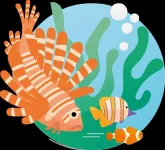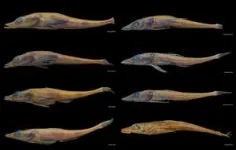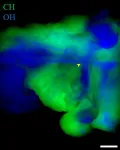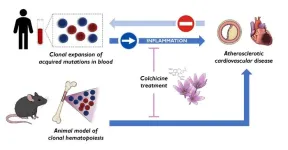(Press-News.org) Worldwide survey by Goethe University FrankfurtFRANKFURT. Of the estimated 10 million, mostly still undiscovered species of flora and fauna on Earth, one million could become extinct in the next decades. This loss of biodiversity would have dramatic consequences, as animals and plants are providers of multiple services: They maintain ecosystems, ensure a more balanced climate on our planet, and supply us with food and active substances for medical drugs. Put bluntly: Without biodiversity, we humans will not survive.
That is why there is an urgent need for resolute political measures to counter the “sixth mass extinction” in Earth’s history. One group of people who are particularly important are today’s students of environment-related subjects. Many of them will foreseeably occupy influential positions in environmental policy and business in the future – and play a key role in deciding whether the global decline in biodiversity is combated effectively.
But just how knowledgeable are the decision-makers of tomorrow? Are they capable of identifying the main causes of biodiversity for what they are – and distinguish them from factors that have no influence whatsoever on biodiversity? “Our study is the first to have examined these questions scientifically at the global level,” says Dr. Matthias Kleespies from the Department of Didactics in the Biological Sciences at Goethe University Frankfurt.
Together with other researchers in Frankfurt, Kleespies conducted an online survey among around 4,400 students on environment-related degree programs in 37 countries, who were given a questionnaire listing eight drivers of global biodiversity loss. These included the five actual causes: climate change (more and more droughts as well as other consequences of global warming), overexploitation (such as overfishing), habitat loss (for example through deforestation), displacement by invasive species, and pollution (air pollution, plastic waste, oil spills). The questionnaire additionally listed three factors that have little or no impact on biodiversity: electrosmog, factory and traffic noise, and the internet. The interviewees were asked to indicate the extent to which they thought the eight factors were responsible for the decline in biodiversity. The scale ranged from 1 (minor influence) to 5 (major influence).
To analyze the completed questionnaires, the researchers used a special method that recognizes patterns in data. The outcome was eight different groups with clusters of specific, easily distinguishable response types. Kleespies explains: “In response type 1, for example, all the main causes are recognized except for climate change. The students underestimate its influence on the decline in biodiversity.” In type 2, on the other hand, pollution plays a subordinate role, and in type 7 invasive species. Type 3 is a special form in which all the main causes are underestimated and not even distinguished from irrelevant factors such as noise. “Fortunately, the number of such responses was comparatively low,” says Kleespies. Overall, the eight response types occur with varying frequency in the countries under study.
In the next step of the evaluation, the research team examined the background to the responses: What induces the different response types? Here, the researchers incorporated country-specific indicators: the country’s CO2 emissions as well as prosperity, environment and biodiversity indicators. Kleespies: “We found that these indicators substantially influence student perception in the respective country.”
In response type 1, for example, climate change is underestimated as a driver. In countries with very high CO2 emissions – such as Russia, China and Saudi Arabia – type 1 occurs far more frequently. “Although our data cannot explain why this is the case, we suspect that the students in question in these countries are less aware. They do not learn at university that climate change, too, exacerbates biodiversity loss.” Furthermore, it has to do with their own country’s contribution to climate change. Perhaps people are not so ready to admit how extensive it is.
In response type 2 – pollution as an underestimated factor – a correlation between the students’ perception and country-specific indicators is also recognizable, but in a different form. In affluent countries with healthier ecosystems – such as Australia, Sweden and Germany – the students underestimate the pollution factor more frequently. Pollution is presumably not generally perceived as a problem in these countries, assumes Kleespies, and therefore also not seen to be one of the main causes of global biodiversity loss. Response type 7, on the other hand, which greatly underestimates the influence of invasive species, is more widespread in countries such as Nigeria and Kenya, where such species are less common. In Australia and Spain, by contrast, type 7 is rare – although it is precisely there that invasive species present a major problem.
What conclusions does Kleespies draw from the study? “It shows for the first time the vast gaps in perception among the next generation of decision-makers in the environmental sector as far as biodiversity loss and its causes are concerned. We need to close these gaps.” This is where today’s decision-makers at universities and in politics come into play. They must create the overall framework so that all the causes of this complex problem are treated in environmental studies at universities in the respective country. “Biodiversity loss affects us all; it is a global problem. That is why students on environment-related degree programs need to think globally, regardless of their country of origin.” The study is an appeal in this direction.
END
Biodiversity loss: Many students of environment-related subjects are partly unaware of the causes
Worldwide survey by Goethe University Frankfurt reveals possible explanations for the knowledge gaps of future environmental experts
2024-08-30
ELSE PRESS RELEASES FROM THIS DATE:
UTHealth Houston and Baylor College of Medicine collaborate on first CDC Injury Control Research Center in Southwest, established to study injury and violence prevention
2024-08-30
The only Injury Control Research Center in Texas has been established by the Centers for Disease Control and Prevention at UTHealth Houston in partnership with Baylor College of Medicine.
“I’m beyond thrilled to bring an Injury Control Research Center to Texas,” said Jeff Temple, PhD, director of the new center and associate dean for clinical research at UTHealth Houston School of Behavioral Health Sciences. “This collaboration between the community, policymakers, UTHealth Houston, and Baylor College of Medicine will undoubtedly save lives.”
An Injury Control Research ...
New findings on TB could change how we treat inflammatory disorders
2024-08-30
Tuberculosis is a confounding scourge. It’s the leading cause of death from infectious disease in the world, and yet it’s estimated that those deaths represent perhaps 5% of infections with Mycobacterium tuberculosis (Mtb). Antibiotics can take credit for saving the lives of some of those with Mtb, but a chasm nevertheless persists between the prevalence of infection and the targeted severity of its impact. A growing body of evidence suggests genetic vulnerabilities to TB account for that gap.
Now researchers from ...
Research Spotlight: A blood-based assay for the detection of IDH1.R132H-mutant gliomas
2024-08-30
Leonora Balaj, PhD, an investigator in the department of Neurosurgery at Massachusetts General Hospital and an assistant professor of Neurosurgery at Harvard Medical School, is co-senior author of a new paper in Nature Communications, Clinical Utility of a Blood Based Assay for the Detection of IDH1.R132H-Mutant Gliomas.
Bob Carter, MD, chair of Neurosurgery at Mass General, is co-senior author of the study. Syeda Maheen Batool, MD, an instructor in investigation in Neurosurgery at Mass General, is lead author.
Background:
Glioma represents the most common central nervous system cancer in adults. The current ...
Genomic dark matter solves butterfly evolutionary riddle
2024-08-30
[Note: High-resolution images related to this research available for download at this link. Caption and credit information provided.]
WASHINGTON (August 30, 2024) — A team of international researchers has uncovered a surprising genetic mechanism that influences the vibrant and complex patterns on butterfly wings. In a study published in the Proceedings of the National Academy of Sciences, the team, led by Luca Livraghi at the George Washington University and the University of Cambridge, discovered ...
Like people, vultures get set in their ways and have fewer friends as they age
2024-08-30
Key takeaways
Young griffon vultures move frequently between sleeping sites in different locations, interacting with many friends.
They get set in their ways as they age and roost in the same spots with the same individuals; older vultures follow the same paths.
Roosts act as information hubs; older vultures may have a more thorough knowledge of where to find food resources and less need to learn about them from other vultures.
If you’d rather be watching TV on your couch than dancing at the club, you might have something in common with aging ...
Not just a ‘bad guy,’ Tau also plays a ‘good guy’ role protecting our brains
2024-08-30
A study by researchers at Baylor College of Medicine and the Jan and Dan Duncan Neurological Research Institute (Duncan NRI) at Texas Children’s Hospital, reveals that the protein Tau – a key player implicated in several neurodegenerative conditions including Alzheimer’s disease – also plays a positive role in the brain. Tau mitigates neuronal damage caused by excessive reactive oxygen species (ROS) or free radicals and promotes healthy aging. The study was published in Nature Neuroscience.
“ROS ...
Doughnut-shaped region found inside Earth’s core deepens understanding of planet’s magnetic field
2024-08-30
A doughnut-shaped region thousands of kilometres beneath our feet within Earth’s liquid core has been discovered by scientists from The Australian National University (ANU), providing new clues about the dynamics of our planet’s magnetic field.
The structure within Earth’s liquid core is found only at low latitudes and sits parallel to the equator. According to ANU seismologists, it has remained undetected until now.
The Earth has two core layers: the inner core, a solid layer, and the outer core, a liquid layer. Surrounding the Earth’s core is the mantle. The ...
Study combines data, molecular simulations to accelerate drug discovery
2024-08-30
Researchers from the University of Cincinnati College of Medicine and Cincinnati Children’s Hospital have found a new method to increase both speed and success rates in drug discovery.
The study, published Aug. 30 in the journal Science Advances, offers renewed promise when it comes to discovering new drugs.
“The hope is we can speed up the timeline of drug discovery from years to months,” said Alex Thorman, PhD, co-first author and a postdoctoral fellow in the Department of Environmental and Public ...
NCT/UCC Dresden: Millions in funding from the Chan Zuckerberg Initiative for state-of-the-art imaging to accurately detect minute tumors
2024-08-30
The imaging techniques currently used in biological research cannot penetrate into deeper tissue layers. In cancer treatment, this means that remnants of tumors or individual cancer cells at tumor margins and in lymph nodes are not visible. Doctors performing surgery are therefore repeatedly faced with the difficult question of whether all of the affected tissue has actually been removed. For the patient's quality of life, however, the complete removal of the tumor is just as essential as the preservation of healthy tissue ...
CNIC scientists discover a new cardiovascular risk factor and identify a drug able to reduce its effects
2024-08-30
To the known risk factors for cardiovascular disease—high blood pressure, high cholesterol, diabetes, overweight and obesity, smoking, and physical inactivity—a new one has to be added: clonal hematopoiesis. This condition is triggered by acquired mutations in blood stem cells and was already known to be associated with an elevated cardiovascular risk. However, until now it was uncertain if clonal hematopoiesis was a cause or consequence of cardiovascular disease. Now, a new study published in Nature Medicine and carried out by researchers at the Centro Nacional de Investigaciones Cardiovasculares (CNIC) resolves this critical debate ...
LAST 30 PRESS RELEASES:
Numbers in our sights affect how we perceive space
SIMJ announces global collaborative book project in commemoration of its 75th anniversary
Air pollution exposure and birth weight
Obstructive sleep apnea risk and mental health conditions among older adults
How talking slows eye movements behind the wheel
The Ceramic Society of Japan’s Oxoate Ceramics Research Association launches new international book project
Heart-brain connection: international study reveals the role of the vagus nerve in keeping the heart young
Researchers identify Rb1 as a predictive biomarker for a new therapeutic strategy in some breast cancers
Survey reveals ethical gaps slowing AI adoption in pediatric surgery
Stimulant ADHD medications work differently than thought
AI overestimates how smart people are, according to HSE economists
HSE researchers create genome-wide map of quadruplexes
Scientists boost cell "powerhouses" to burn more calories
Automatic label checking: The missing step in making reliable medical AI
Low daily alcohol intake linked to 50% heightened mouth cancer risk in India
American Meteorological Society announces Rick Spinrad as 2026 President-Elect
Biomass-based carbon capture spotlighted in newly released global climate webinar recording
Illuminating invisible nano pollutants: advanced bioimaging tracks the full journey of emerging nanoscale contaminants in living systems
How does age affect recovery from spinal cord injury?
Novel AI tool offers prognosis for patients with head and neck cancer
Fathers’ microplastic exposure tied to their children’s metabolic problems
Research validates laboratory model for studying high-grade serous ovarian cancer
SIR 2026 delivers transformative breakthroughs in minimally invasive medicine to improve patient care
Stem Cell Reports most downloaded papers of 2025 highlight the breadth and impact of stem cell research
Oxford-led study estimates NHS spends around 3% of its primary and secondary care budget on the health impacts of heat and cold in England
A researcher’s long quest leads to a smart composite breakthrough
Urban wild bees act as “microbial sensors” of city health.
New study finds where you live affects recovery after a hip fracture
Forecasting the impact of fully automated vehicle adoption on US road traffic injuries
Alcohol-related hospitalizations from 2016 to 2022
[Press-News.org] Biodiversity loss: Many students of environment-related subjects are partly unaware of the causesWorldwide survey by Goethe University Frankfurt reveals possible explanations for the knowledge gaps of future environmental experts






